Gelatin in the production of water stable shrimp feeds
Binders: Gelatin as alternative for urea formaldehyde and wheat gluten in the production of water stable shrimp feeds
Published: September 3, 2008
By: Eric De Muylder, Hans Hage and Geert van der Velden - Published on Aquafeed International magazine (Volume 11, Issue 2 – 2008) - Article courtesy of Perendale Publishers
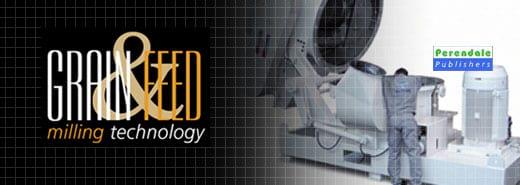
Shrimp are external masticators, meaning that they chew their feed outside their mouth and will not ingest the feed at once. Shrimp prefer soft pellets. Typically, in semi-intensive farming, shrimp feed pellets will stay in the water for 15 - 60 minutes before the shrimp consume them, but they can lie in water for several hours before consumption.
Feeds should remain water-stable during this period. Meanwhile, feed pellets swell by taking up water that makes them soft.
Producing water stable feeds that become soft by water uptake but do not fall apart is a challenge for every shrimp feed producer. Most shrimp feeds are pelleted and binders are widely used to obtain good water stability. A binder generally forms a network through the feed pellet and holds it together while it reacts to the water.
Shrimp feeds often suffer from excessive handling from the production site to the shrimp farm. This can cause dust formation in the feed bags. This dust will float on the water of the ponds, it cannot be consumed by the shrimp and will contribute to pond pollution.
The mostly widely used binders are urea formaldehyde, wheat gluten and gelatin. Gelatinizing the starch is often used to improve water stability. This is achieved by excessive heating via preconditioning, postconditioning or extrusion. Wheat flour is mostly used as the starch source. However, there is a large price difference between wheat flour and other starch sources such as tapioca. A higher inclusion rate of tapioca in shrimp feeds will reduce the feed cost without affecting the nutritional quality.
Most binders are only functional once. Gelatinized starch, wheat gluten and urea formaldehyde will not work again once they have heated and cooled down. Gelatin, however, can be heated and cooled down several times and will still keep its functionality.

Urea formaldehyde is a synthetic binder with no nutritional value. Fish or shrimp cannot digest it. Instead it adds nitrogen (false protein) to the diet that ends up as ammonia in the ponds.
In the process, formaldehyde is bound to the NH2 group of urea to form a polymer. However, the formaldehyde can also bind to other amine (NH2) groups in other products such as melamine or amino acids. Formaldehyde is a cross-linking agent which inactivates, stabilizes or immobilizes proteins. Urea formaldehyde has been shown to react with the amino group of N-terminal amino acid residue and the sidechains of arginine, cysteine, histidine and lysine residues. Furthermore, urea formaldehyde is not permitted either in the EU and the USA, leaving only wheat gluten and gelatin as real options in these regions.
Finally, it is advisable to use nutritional binders that have a high digestibility.
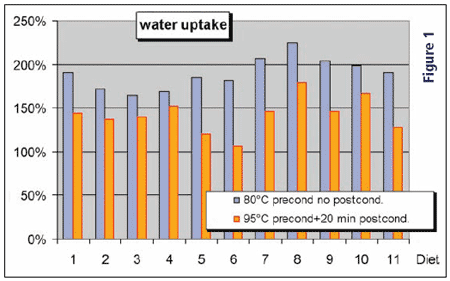
Goals
The goals of this study were to determine the optimal inclusion level of a gelatin-based binder, Pro-Bind Plus (PBP), in pelleted shrimp feeds, and to compare this product with wheat gluten and urea formaldehyde. The optimal processing parameters - temperature and time - were also evaluated.
Lastly, we investigated the possibility of using tapioca, instead of wheat flour, with Pro-Bind Plus in pelleted shrimp feeds.

Analysis
Analysis was done at the laboratory of Sonac Vuren and at CreveTec.
These 77 samples were analyzed for moisture content, water uptake, leaching and hardness.
Water uptake
A sample of 10 g is mixed with 200 ml water at 25°C for one hour. The water and feed is sieved for one minute and the residue weighed.
Leaching
A sample of 5g is mixed with 195 ml fresh water at 25°C for one hour. It is mixed for 10 minutes and left in the water for a further 50 minutes. The water is analyzed for COD. One g of feed corresponds to 0,66 g of COD. The percent COD leached can thus be calculated.
Leaching of proteins was done as above, but the water is measured for Kjeldahl N. Feed contains 38 percent protein, which corresponds with 6,08 percent N. In this manner we can calculate a percentage leaching of proteins.
Hardness
Mengen-Pfost (Vuren): a dust free sample is tumbled for several minutes. It is then sieved and the amount of dust is calculated as a percentage of the original sample.
Hardness was measured according to the Kahl method. (Figure 1)
RESULTS
Water uptake
There is little influence of binder type (wheat gluten or Pro-Bind Plus) or processing method on water uptake.
However, feeds with tapioca have a higher water uptake than feeds with wheat flour. But feeds containing urea formaldehyde (with postconditioning) have a lower water uptake than other feeds. (See Figure 1)

Leaching of Dry Matter
The addition of binders did not significantly affect the leaching rates, except for urea formaldehyde. The lower leaching rate with urea formaldehyde is probably the result of lower water uptake. Formulas with tapioca have higher leaching rates than formulas with wheat flour, also probably a result of higher water uptake. Postconditioning reduces leaching and preconditioning at a higher temperature (95°C) is better than at 80°C. This can be seen in Figure 2.
Leaching is mostly related to water uptake as shown in Figure 3. Feeds with a lower water uptake leach less dry matter.
Protein leaching
Neither the addition of binders nor processing conditions influenced the leaching rates of proteins - Figure 4. Leaching of proteins is most probably a function of the protein solubility of the raw materials rather than a consequence of processing or the addition of binders.
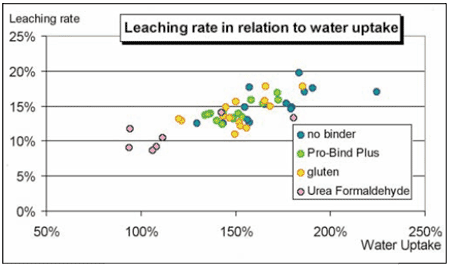

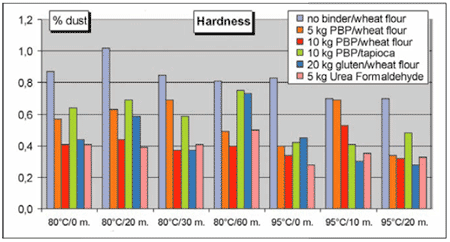
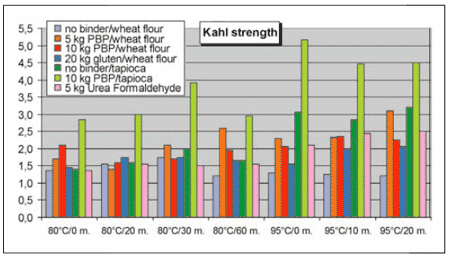
Hardness
The addition of Pro-Bind Plus reduced the formation of dust after tumbling. 10kg Pro-Bind Plus per tonne appears to be an optimal level, giving similar results to 20kg wheat gluten and 5kg urea formaldehyde. Formulas with tapioca show good hardness when processed at 95°C preconditioning - see Figure 5.
Kahl strength
The addition of Pro-Bind Plus improves the strength of shrimp feed pellets. 5kg Pro-Bind Plus gives better pellet strength than 20kg wheat gluten or 5kg urea formaldehyde. There is a clear synergetic effect between tapioca and 10kg per tonne Pro-Bind Plus (see Figure 6).
Discussion
Gelatin-based binders are a good alternative to gluten and urea formaldehyde. Gelatin and gluten have the advantage of being fully digestible and contain protein. Feeds with a higher water uptake show higher leaching rates. This is logical since dry matter can only leach out of the pellet when it dissolves in the water that penetrates the pellet. Since shrimp need soft pellets, rapid water uptake offers both an advantage (softness) and a disadvantage (leaching).
The utilization of gelatin in combination with tapioca produces extra strong pellets, which stay intact during handling. Replacing wheat flour by tapioca can reduce the cost of feeds substantially.
* Pro-Bind Plus is produced by SONAC BV.
Authors: Eric De Muylder(1), Hans Hage(2) and Geert van der Velden(3)
(1) Consultant CreveTec, Belgium
(2) Technical manager Sonac Vuren
(3) Marketing manager Sonac BV
ACKNOWLEDGEMENT____________________________ We greatly thank the kind collaboration of Perendale Publishers (UK), whose contribution of technical articles appeared on their magazines AQUAFEED and GRAIN & FEED MILLING TECHNOLOGY is deeply appreciated by Engormix.com and its community members. |
Related topics
Recommend
Comment
Share
Recommend
Reply
Recommend
Reply
28 de octubre de 2015
how to prepare binding gels for to add protein suppliments or any medicine to prawns which should mix with feed
Recommend
Reply

Would you like to discuss another topic? Create a new post to engage with experts in the community.






